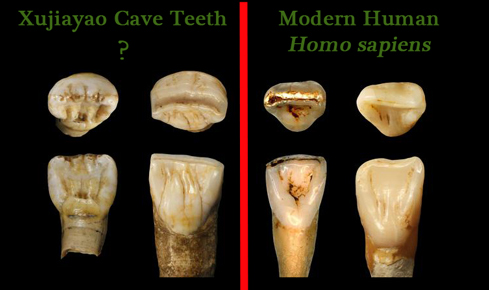Hominin Fossils from Northern China Could be a New Species
A new study of fossilised teeth and jaw fragments found in a cave back in 1976, suggests the possibility of an unknown species of human living in northern China between 120,000 and 60,000 years ago. A paper published in the American Journal of Physical Anthropology concludes that the teeth have similarities with Homo neanderthalensis and the much older hominid species H. erectus.
Ancient Hominins
The research was carried out by a team of scientists from Beijing’s Institute of Vertebrate Palaeontology and Palaeoanthropology in conjunction with anthropologists from the National Research Centre on Human Evolution (Burgos, Spain). The fossils represent the remains of four individuals and the teeth do not resemble those of modern humans. Instead, they possess a range of primitive and more derived features, this could indicate a new species, yet to be described or possibly a hybrid hominid, a result of interbreeding between two already described species. The fossils were found in a cave close to the village of Xujiayao, Yanggao County in Northern China. The site is approximately 120 miles west of Beijing.
María Martinón-Torres (National Research Centre on Human Evolution), explained that the research team examined the size and shape of the tooth crowns and their associated root system, the groves, cusps and crests. These features were then compared to over five thousand fossil teeth representing nearly all the known hominin species. The features of teeth are diagnostic when it comes to determining species and phylogenetic relationships.
The Xujiayao Fossil Teeth Compared to a Modern Human
Picture credit: Dr Martinón-Torres with additional annotation from Everything Dinosaur
Hominin Fossils from China
Dr Martinón-Torres, a specialist in ancient hominin dentition stated:
“Teeth are like landscapes in miniature. Each of those slopes, grooves and valleys define a pattern or combination of features that can be distinctive of a population.”
Although a number of palaeoanthropologists have challenged the team’s results and all agree that more fossil material from ancient Asian hominins is required so that a more complete picture can be built up, this study does raise the possibility that there may have been an as yet, unknown species of human living in northern China as recently as sixty thousand years ago.
Isolated Pockets of Early Hominins
Given the size of Asia and its relative remoteness thanks to foreboding geological features such as the Ural mountains and the Himalayas, it is not surprising that isolated pockets of early hominins could have evolved distinct characteristics. Or indeed, given the harsh environment and tough lives of these ancient humans it is not entirely surprising that interbreeding did occur between closely related species that overlapped territories. Team members at Everything Dinosaur predict that more hominin fossils will be found in Asia that further complicate the relationships between the various recognised species.
Ancient Human Remains
Back in 2012, Everything Dinosaur reported on a study of human fossil remains found in south China that could represent a new species of hominin. These ancient humans were nicknamed the “Red Deer People” and they lived much more recently than the Xujiayao hominins. The research was carried out by scientists from the University of New South Wales and one of the researchers involved in this earlier study, Darren Curnoe, supports the idea of the Xujiayao fossils being a separate species. He stated that although the sample was small, the unique characteristics of the teeth did suggest that a new species had been found.
The Associate Professor commented:
“It strongly suggests the presence of a previously unrecognised species. There’s little doubt in my mind that these teeth stand out as something unique.”
To read more about the research into China’s “Red Deer People”: Stone Age Remains from Southern China Might Represent Entirely New Human Species.
Most palaeoanthropologists accept that from the Middle to the early Late Pleistocene Epoch, a time interval that spans from about 340,000 years ago to 90,000 years ago, Neanderthals occupied Europe and western Asia. Anatomically modern humans were present in Africa, but the paucity of fossil material prevents scientists from describing the hominin populations of most of Asia. Furthermore, the evolutionary interaction between eastern populations of hominins and those from Europe and Africa remains poorly understood. The Xujiayao teeth sample expands the variability for early Late Pleistocene hominin fossils and also suggest that a primitive early human lineage may have survived into the Late Pleistocene in northern China.
Visit Everything Dinosaur’s website: Everything Dinosaur.







Leave A Comment